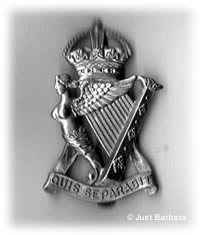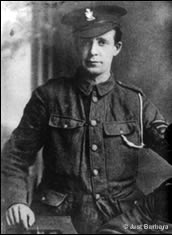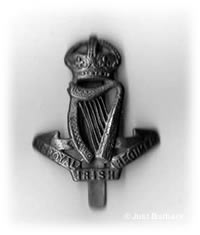My ‘family treasures’ are my grandfather’s cap badges from when he served as a Lance Sargeant in the 11th Royal Irish Rifles of the 109th Brigade of the 36th Ulster Division during World War One. After his death, both badges were left to my dad and on his death, to me. So you can imagine how very precious they are.
My grandfather, John Alexander Whitley, was born in Holywood, County Down, Northern Ireland.
 |  |  |
The Ulster division was made up of Protestants who all knew each other and joined up together, and as most Protestants were opposed to a united Ireland and wished to remain British, this proved advantageous to the British Government who were concerned that they could start a revolution.
The Ulster Memorial Tower now stands close to the site of the Schwaben Redoubt, which lies between the River Ancre and the town of Thiepval. It was here that the 109th Brigade of the 36th Ulster Division attacked on the morning of the 1st of July 1916, the first day of the Battle of the Somme.
At 7.30 am the bugles sounded the advance, the officers’ whistles blew and my grandad and his mates climbed over the parapet and into history.
They crossed into no man’s land and achieved their objective, but couldn’t hold it despite desperate fighting, and eventually had to retire at a cost of massive casualties. The fallen of that day had to lie in the open until the November until it was safe to collect them.
Grandad’s battle ended early that day too, when he was machine gunned and left lying amongst the barbed wire. Eventually he was found by two English Tommies who couldn’t carry him back, but promised to send stretcher bearers, although none came. He would always feel bad about it, but as one of his sons would later say, “who’s to say that those boys ever made it back to tell anyone?”
{xtypo_quote_right}My grandad and his mates climbed over the parapet and into history{/xtypo_quote_right}He wasn’t one to lie back and die, so when night fell he started to drag himself back towards his own lines. Overshooting the Ulster trenches he arrived at an English one. Its occupants thought that he was a German who had come to lob grenades at them, so were about to shoot him.
John was one of the lucky ones because he made it home, but please spare a thought this Remembrance Sunday for those boys who didn’t.
He was a lovely soft spoken man who didn’t consider himself heroic at all. He recovered from his injuries and was demobbed in 1918, when he married his sweetheart, Mary Anne Foster Hamilton.
They lived first in Belfast and then were offered an ex-serviceman’s house in Holywood, where they raised eight children. It must have seemed like the ultimate in luxury, with three bedrooms, a bathroom and an inside toilet. Although the toilet was off a little lobby just inside the back door, so was always freezing cold whatever the weather.
He called the house ‘Martinsart’ after the village where he left for battle on that fateful day, and even though his long term health was affected by his injuries, he lived until he was 64 years old, giving me the privilege of knowing him.
Just Barbara
© Just Barbara 2008
SOURCES
A Popular History Of The Great War by Sir J. A. Hammerton
The History Of The 36th (Ulster) Division by Cyril Falls
[/et_pb_text][/et_pb_column][/et_pb_row][/et_pb_section]